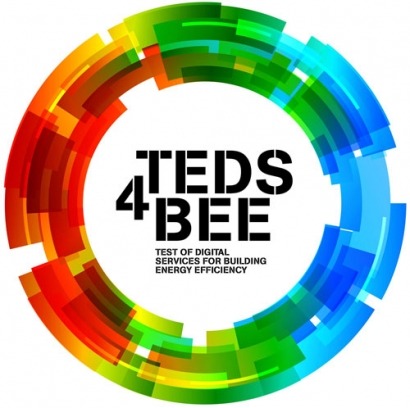
A project designed for energy saving and sustainability
The TEDS4BEE project is part of the Competitiveness and Innovation Program (CIP) adopted by the European Union in 2007 and which promotes the use of Information and Communication Technologies (ICT), green technologies and renewable energy sources. Since then, these policies have placed particular emphasis on areas of public interest, given their importance in the European economy and the unique solutions that ICT can contribute to challenges such as improving energy efficiency in public administrations. The projects in this program must integrate innovative digital services in order to achieve improvements in energy efficiency and reduce emissions in cities (between 15% and 30%), promoting and accelerating the adoption of these services on a large scale.
Under these auspices, TEDS4BEE (Test of Digital Services for Building Energy Efficiency) was created in 2013 with a budget close to € 4 million, and the project has deployed a digital service currently operating in 16 public buildings in five European countries. The diversity of buildings (sports centers, hospitals, public administration buildings, etc.), as well as countries, constitutes an excellent case study owing to the wide variety of types, uses and weather.
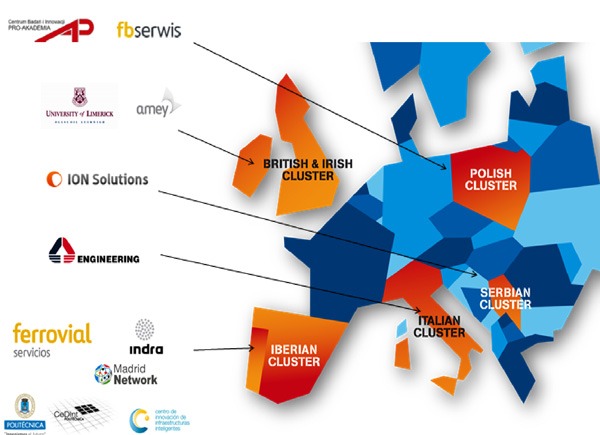
Location of the project partners in Europe
The digital service deployed in these buildings is EMMOS (Energy Management and Monitoring Operational System), a service that provides a mechanism to monitor and forecast energy consumption, besides providing cost models for buildings.
In its consortium, TEDS4BEE, in line with the guidelines of the European Commission, meets institutions covering the entire value chain (ICT suppliers, energy service companies and owners of public buildings) and other closely related bodies (universities, research centers and business associations). In all, the consortium led by Ferrovial Servicios consists of thirteen institutions from seven European countries.
EMMOS: A mature, flexible and user-friendly solution
EMMOS is intended as a comprehensive solution to improve maintenance in buildings, to save energy and reduce greenhouse gas emissions.
This platform is based on software that controls, analyzes and contrasts the energy efficiency of buildings. The software provides a mechanism to monitor activity, the behaviour of the building and where energy is consumed. It is also a tool to manage energy costs and simulate and suggest steps to improve energy efficiency.
The platform, covering multiple buildings and contracts, includes a database that stores data on energy consumption, external temperature variations and any other variable the building manager wants to include. Besides recording variables over time, EMMOS registers data that undergo infrequent changes (type of construction, location, etc.) allowing the comparison of data between similar buildings, and the generation of trends and predictions regarding energy performance.
By using EMMOS data, building managers are therefore able to produce a series of reports to determine whether they are exceeding desired energy consumption, discover areas that can be improved, and predict how investing in new technology or assets would affect consumption.
In this regard, EMMOS offers two types of reports. On the one hand, the building manager can create custom reports, configured, say, to display historical data on consumption (hourly, daily, weekly, monthly or yearly), comparative reports between power consumption compared to emissions of greenhouse gases, or to compare key performance indicators (KPIs).
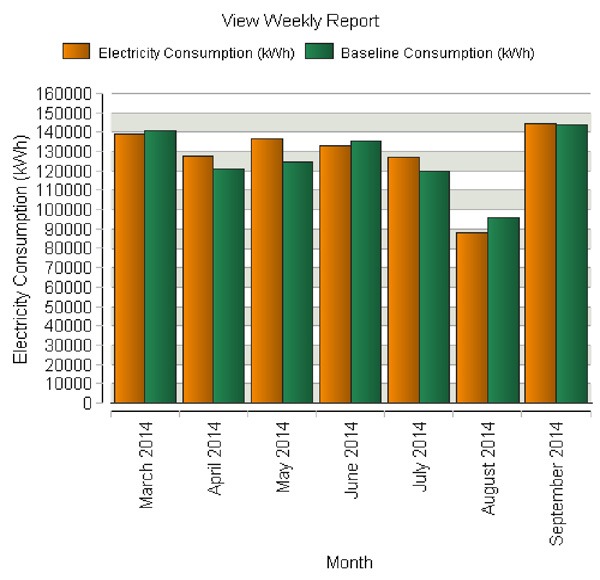
Example of comparison of current electricity consumption compared to baseline.
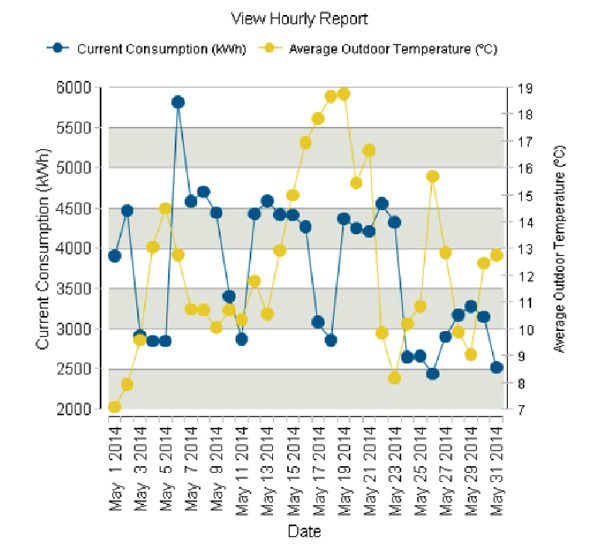
Example of daily electricity consumption versus outdoor temperature.
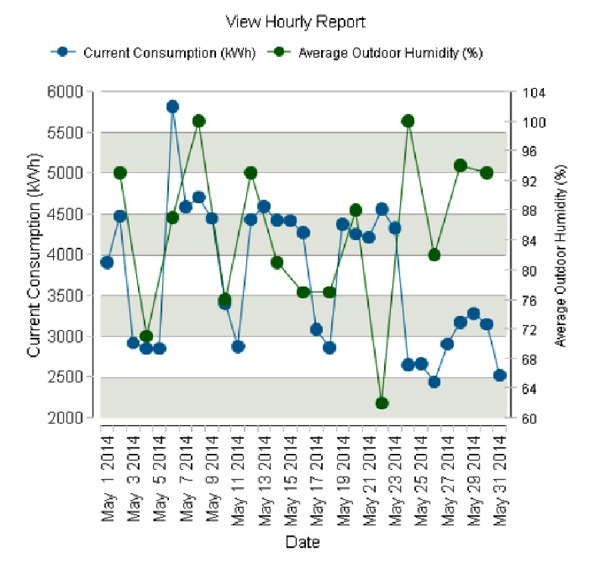
Example of daily electricity consumption versus external moisture.
Secondly, EMMOS can produce extremely thorough reports enabling the administrator to make comparisons in terms of energy consumption between two buildings or compare a selected building with a list of buildings and classify them according to established efficiency criteria. It also produces forecasts for the energy consumption of a building during the following twelve months. Reports outlining energy return allow the administrator to analyze energy savings and the returns on any investment made to improve the facilities.
EMMOS collects data both manually and automatically. Smart Meter and BMS (Building Management Systems) readings are put through automated software. EMMOS is flexible and adaptable to any setting. In this aspect, the interfaces being used are both native (e.g. Modbus protocol Interface) and generic (e.g. 963 Trend database, FTP, Web, climate control, etc.).
Thus the EMMOS toolset allows for data analysis and recommends improvements, helps in decision making, and provides quantifiable evidence that the modifications have led to energy saving and reduced the carbon footprint.
Development of the TEDS4BEE project
Since its launch in February 2013, the consortium began to identify the facilities, devices, systems and other features in the buildings involved in the project. This information was required to identify subsequent adaptations both in the Digital Service (EMMOS) and in the buildings to ensure proper integration.
A methodology was also developed for the project based on ISO 50001 (International Standard for Energy Management Systems). This offers common procedures for work and communication at all levels of project and building management, both organizationally and technically.
Four kinds of indicators were designed to evaluate the Digital Service: energy performance indicators (building level EnPIs, and global CEnPIs) and user acceptance indicators (UAIs at building level and CUAIs globally).
To ensure integration, minor adjustments have been made to the buildings that allow communication between the control system and the cloud hosting EMMOS.
The pilot buildings are very different, not only because of their location but also due to their facilities and possibility of integration. However, EMMOS offers great flexibility with the ability to contact any system, even several simultaneously (e.g. accountants, BMS, manual data, etc.) in order to collect the maximum amount of data to allow the operator to make simple decisions about energy efficiency measures.
Following the deployment phase in pilot buildings there comes the operation phase. Here data on consumption, behavior and weather are collected, which, after continuous analysis and the use of predefined control indicators, make it possible to verify that the actions determined by EMMOS have produced the expected savings. Importantly, most of these measures do not involve any investment for the building owner, and are based on fine adjustments and to user habits.
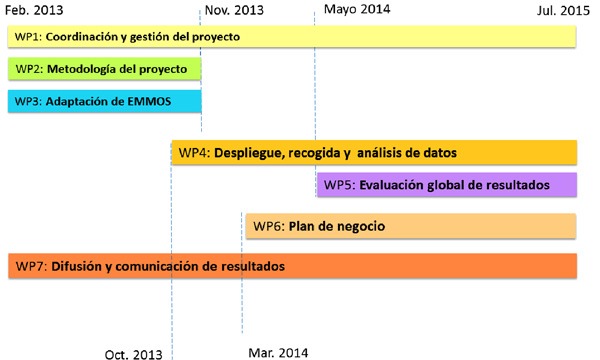
Different phases of the TEDS4BEE project.
In fact, in some buildings, the first steps have provided an energy reduction of around 15%. For example, thanks to EMMOS, the Clinical Center of Vojvodina, Novi Sad (Serbia), discovered a way to manage the fans more efficiently, thereby saving at least 1.5 MWh of electricity per month, accounting for 13 % savings overall. Similarly, adjustments to the settings of the air handling units (AHU) are being tested at the England / Ireland pilot cluster building (Buttershaw Business and Enterprise College (B1)) by turning them off during the school holidays. This measure is thought to represent savings and an impact on power consumption will be seen in the coming months.
Stakeholders Platform, further support for the project.
In order to improve project development and promote awareness and the adoption of these solutions on a larger scale, a Stakeholders platform has been activated, composed of representatives of public and private entities that cover the entire value chain. The platform is chaired by Salvador Urquía (Business Development Director of Ferrovial Servicios), with José Antonio González (Strategic Development Director of enerTIC) acting as vice president, and is coordinated by Madrid Network and CI3.
Throughout the project, the Stakeholders will hold a series of meetings to advise the consortium on issues related to project strategy, optimizing their applicability and the exploitation of their technological achievements. The first meeting took place in Madrid on October 30, and here Stakeholders had the opportunity to witness a demonstration of EMMOS and share their impressions on early progress.

